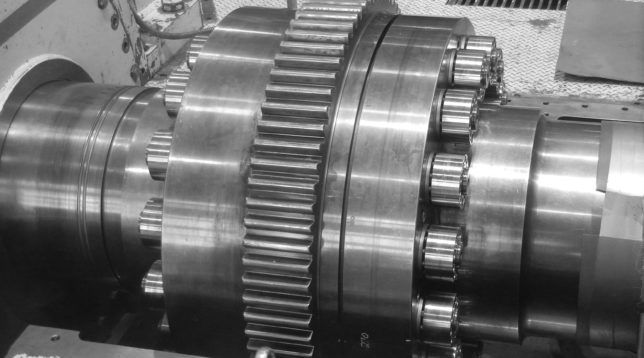COUPLING BOLTS
HOW TO AVOID THE VARIOUS CHALLENGES RELATED TO SEIZED COUPLING BOLTS
By Steve Brown

Caption: Superbolt EzFit assembled on a turbine generator coupling. This mechanical expansion bolt combines multi-jackbolt tensioners and an expansion bolt with controlled sleeve expansion
Couplings play an important role in maintaining shaft alignment and transmitting drive. However, they also present their fair share of challenges. This is especially the case when traditional fitted bolts used to secure couplings seize up.
A coupling bolt is a mechanical means of holding two halves of a flanged shaft together to properly transfer the torque while maintaining shaft alignment. Misalignment in steam turbines, for example, causes vibration, puts unnecessary load on bearings, and curtails operation at full power.
High loads associated with the necessary torque transfer within the shaft connections (couplings) can be high. This makes bolting essential. Coupling bolts are complex and large.
High energy tools are needed for maintenance work. The bolts must be closely fitted or interference-fitted with their mating coupling bores to transfer the proper torque. Ideally, one shaft would be used, but this is impossible due to the need for simple maintenance. Bolts must be used to attach the two halves of the shaft together via the coupling.
Standard fitted bolts often used to secure couplings are inexpensive and readily available. However, these bolts and their mating bores require precision machining, extreme tolerances, and high-quality surface finishes.
Operators often have to machine the bolts to fit the bores or rework the bores to match the fitted bolts. Despite this, they never fit perfectly. There is always minute sliding in the joint. Pressure at the four contact points leads to plastic deformation of the flange. As well as failures, this can make it impossible for operators to remove fitted bolts during maintenance.
Galling and seizing
Galling and seizing in bolts are caused by a combination of friction and adhesion between metallic surfaces during sliding. Generally, this appears when fasteners are tightened, as pressure builds up between the sliding thread surfaces. The ductility of the material used in the bolt affects the tendency toward galling: softer materials are more prone to damage.
Galling is common in fasteners made of stainless steel, aluminum, titanium, and various alloys. Once galling has begun, lumps form, which accelerates the process. In extreme cases, galling leads to seizing. The bolt freezes into the hole. Continued tightening may lead to breakage of the bolts, including torn-off threads.
When fitted bolts seize in their bores, operators will try to remove them with breakout tongs, hammers and chillers. If unsuccessful, outage managers call for drilling and boring. But this generally damages flange bores and coupling faces.
An alternate approach is to use expansion bolts. As the bolt’s tapered body and the mating tapered bore sleeve are smaller than the hole itself, operators can install it perfectly by sliding it into the hole. Interference fits are unnecessary, with no need to freeze or heat the bolts. This eliminates radial clearance during the installation process and ensures uniform load distribution during operation.
Expansion bolts are positive locking bolting elements. Due to their increased rigidity, load amplitudes on the shaft line are reduced. Unlike traditional fitted bolts, the amount of radial force in the hole can be controlled.
When tightened axially, the bolt does not decrease in diameter. Accurately known loads combined with an increase in the effective cross section available for power transmission lower shaft stresses and prolong service life.
With modern turbines experiencing more cyclic loads, couplings have to deal with heavy torsional stress during each startup or shut down. A coupling bolting system with zero clearance allows for better torque transfer during these conditions and extends the useful life.
Hydraulic expansion bolts are another option. They are radially fitted during coupling drive operation and perform as clearance bolts during removal. Hydraulic expansion bolts are especially suited for power generation turbines of all types as the time required to fit or remove such bolts is short and can be easily programmed into maintenance schedules.
However, hydraulic expansion bolts have solid sleeves and the expanding sleeve requires very close tolerance between the coupling hole. Operators must use precision machining. Although tolerances on hydraulic expansion bolts are much bigger than traditional fitted bolts, they are still smaller than those of mechanical expansion bolts.
Instead of a solid sleeve, mechanical expansion bolts use a split sleeve which is operated mechanically rather than with high-pressure hydraulics. The split sleeve mates with the machined coupling hole and requires less tolerance on mating parts than is traditionally required with interference fit bolts.
Since the sleeves are installed in clearance conditions and are expandable, the mechanical expansion bolt can accommodate slight hole size variations and hole misalignment.
They are suitable for couplings using bolts of 1-1⁄8" (28mm) diameter or bigger. This technology enables a controlled expansion of the split sleeve. This means that a precise radial force is imparted into the hole.
Designers can calculate the exact radial force needed for optimal expansion. This increases the reliability of the coupling and in turn, the application in which it is installed.
Reliable coupling bolts provide correct driving forces, are easily installed and removed without fear of galling or seizing and provide accurate maintenance scheduling. Traditional fitted bolts suffer from coupling slippage and seizing.
Alternative bolting solutions such has hydraulic and mechanical expansion bolts enable planned outages to be programmed precisely and guarantee optimal operating conditions.